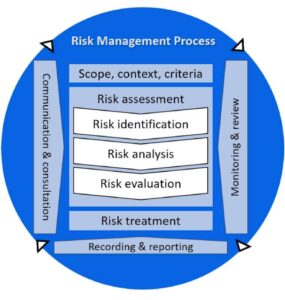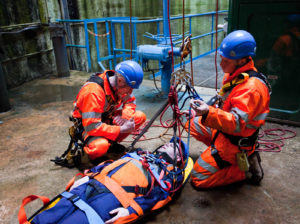Working at height safety
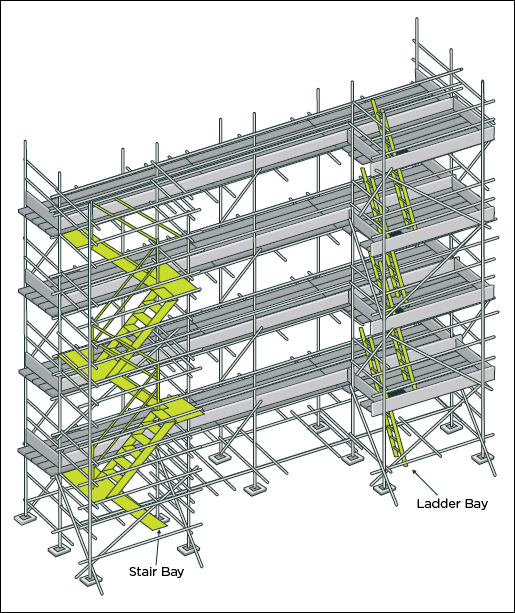
Working at height safety is a very necessary topic to know about. Falls from heights are the most common cause of injury and death in the construction industry. Major causes of accidents include scaffolding or platforms without safety guards, absence of a properly fitted safety harness, brittle roofs and ladders that are not properly supported, positioned and secured.
Scaffolding
Scaffolding is considered a temporary construction and collective protection, can be fixed or mobile, and serves as an auxiliary tool for the execution of works. Scaffolding should be installed by properly trained and competent personnel in most of the countries in gulf scaffolders must be 3rd party certified. Working at height safety

The use of scaffolding is mandatory in construction works where workers work above 4 m. Scaffolding from 8 m high requires the existence of a person responsible for its calculation, stability, execution and consequent maintenance that person is called a scaffolding inspector and the inspector must be 3rd party certified.
The most common causes of scaffolding accidents are due to:
Scaffolding imbalance or sinking
Platform Break
Drop by loss of worker’s balance
Falling materials, tools or material breakage
Preventive measures
The scaffolding area must be protected by barricading, safety signs of warning of the danger of falling objects in order to isolate the worksite. When scaffolding is mounted at pedestrian crossings, well-lit and signposted passageways shall be provided. In places of passage, whenever there is a risk of falling materials, a Safety Net should be fitted.
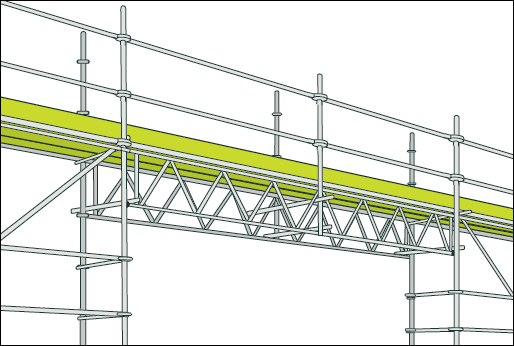
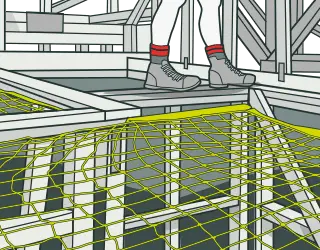

Scaffolding mounted near the passage of vehicles or at places where machinery is maneuverer shall be indicated during the day and at night. In addition to this signage, obstacles of stone or concrete barrier, concrete or even a metal structure may be placed.
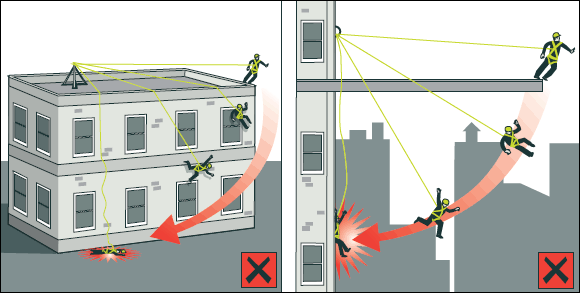
During scaffolding erecting and dismantling work, scaffolders must wear the necessary personal protective equipment, particularly for work at height: protective helmet; fall arrest system (when there is a risk of a worker falling); protective gloves and protective boots.
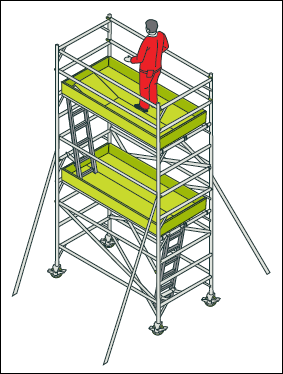
In the case of fixed scaffolding, the plumb bases shall be supported by solid and stable supports, such as wooden props or beams. If they are movable, the scaffolding should have diagonally stabilizing bars called outriggers mounted at the base of the wheels to make the assembly more stable. Wheels mounted on moving foot scaffolding shall be fitted with a brake system called castor locks.

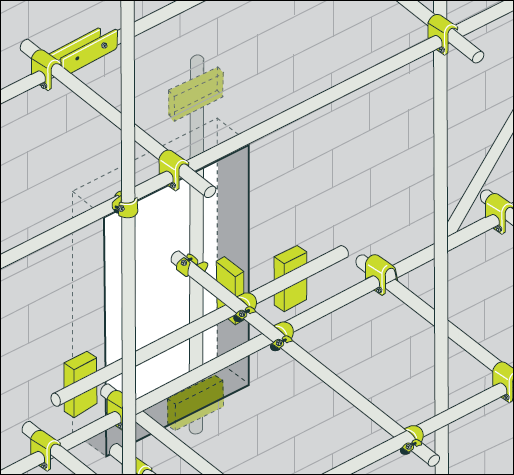
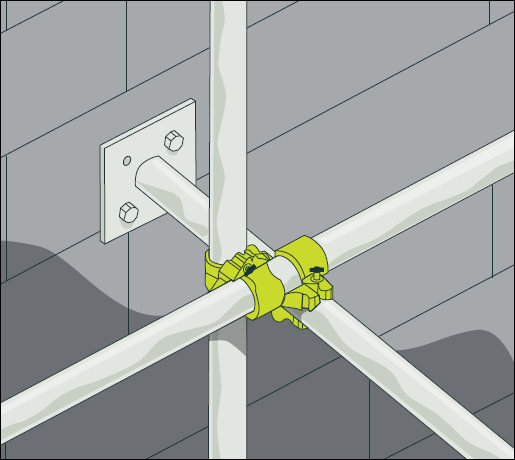

When assembling scaffolding, the upper branch must not be started without the lower levels being completed with all stability elements. The joining elements must be properly tightened, promoting the best fixation between the other scaffolding parts. All constituent elements of a scaffold that are defective should be replaced immediately. Construction scaffolding shall be secured to the building or other existing fixed structures in view of the need for bracing of the structure.
Using Work Platforms
In order to protect work platform users, guards such as railings, an intermediate guard and the footer should be fitted. The work platforms should be wide enough for the worker to move and do his work freely, with the support crossbars fully filled.

Access between work platforms on scaffolding shall be by ladders mounted on independent structures, allowing easy transposition of the gaps to be overcome. On work platforms, the storage of immediate use material is permitted only to prevent platform overload and breakage. At the end of each workday, all materials should be removed and the necessary work platforms cleaned. Working at height safety
In the case of mobile scaffolding, no persons and/or materials should be carried on the scaffolding while the structure is moving. You should not throw materials from work platforms. Loads and materials should be lifted and lowered with the aid of pulleys properly secured to a rigid structure.
When using scaffolding collective protective equipment is not effective or is not possible to assemble, workers must wear personal protective equipment (harness + fall arrest system).
Stairs
The use of portable ladders should take into account some precautions, such as choosing the type of ladders most suited to the type of work, the condition of the ladders and the strength of the supporting surface.
Ladder Placement, Positioning and Fixing
The ladder should be positioned so that the base rests on solidly fixed points that prevent it from sliding. Under no circumstances should the ladder rest on loose material, crates or other objects that may cause it to become unstable or to oscillate. Where it is not possible to place the base of the ladder on a fixed horizontal plane, stabilizers or adjustable feet shall be used.
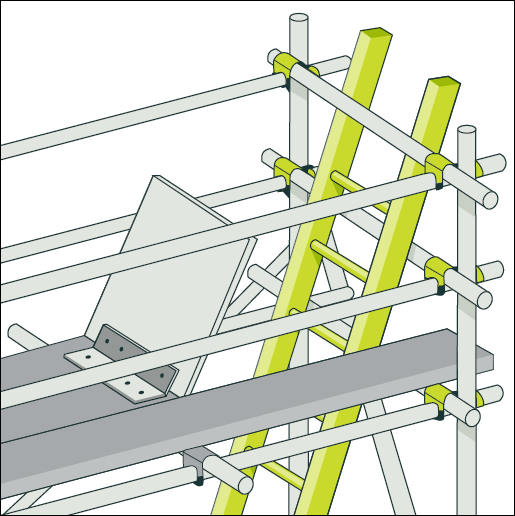
In the case of placing a ladder resting on a façade or structure for climbing a terrace or platform, it should be about 1 meter above the landing point. The top of the ladder should preferably be secured to existing, solidly fixed points.

Where the ladder is not fixed from the ground, the first climb (and the last descent) must be kept safe by a worker at its base. In the absence of a sufficiently strong lashing point, the ladder must be immobilized from the ground.
Using the Ladder
Always look uphill to avoid hitting your head on obstacles in your path. The hands must be free; Only in this way is the rule of 3 support points guaranteed (1 hand + 2 feet or 2 hands + 1 foot). The descent must always be made facing the ladder. Do not pass more than one step at a time or jump from the stairs to the ground. Materials and tools should be carried in a bag or using a service rope; Under no circumstances should they be carried by hand.
During the use of the ladder, there must be no more than one worker on the ladder, except in rescue circumstances, where another may climb to rescue it. The height of the ladder should be sufficient so that the worker does not need to climb beyond the 4th step from the top.
Once the climb is over, at heights of more than 3 meters, fix the fall arrestor to a solidly fixed point and look for the best position for the work to be performed. Clamp with the rope (rope with regulator) around a fixed point whose resistance has been previously checked. Working at height safety
The body of the worker must not laterally exceed the ladder mounts (except the ones that fit) to avoid instability of the ladder. Tools or equipment being used should not be placed on the steps; For this purpose, preferably use harnesses for connecting the tools to the harness and, alternatively, bags, purses or ring clamps.
Personal protective equipment
Protective helmet
Fall arrest system (heights over 3m)
Work mooring system
Safety shoes
Mechanical protective/insulating gloves (depending on the type of work)
Roofs (roofing of buildings)
Working on roofs can be dangerous and it is essential that strict safety standards are in place for both long term and short-term work.
Fall Prevention
Preventive measures should be taken whenever there is a risk of falling when accessing, working on or getting off a roof. Collective fall protection measures should be taken based on the results of the risk assessments before individual protection measures are taken.
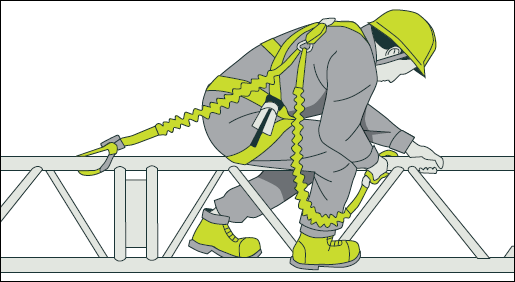
Any fall protection (such as railings) must be strong enough to prevent or stop falls and to prevent workers from being damaged. Fall prevention measures should be implemented before starting work at heights and maintained until completion. When working on roofs, the weather conditions must be taken into account, as ice or wet or windy weather can significantly increase the risk of falling people or materials. What are fall protection systems for scaffolders
Preventive measures
Check what material the cover is made of and its degree of robustness. For sloping roofs or surfaces with a risk of slipping, use roof ladders or red planks. On low strength, roofs apply robust and solidly supported platforms to distribute worker weight over a larger surface. Prevent the worker from leaning on weak points. Place railings and floorboards on the outskirts of the roof when work is being done on this site.
Signal and delimit the openings with railings. For short-term work, the use of fall protection equipment may be sufficient.
Safety Check List for Working at Height:
1. Have you assessed the risks of working at heights?
2. Have you considered the occasional work?
3. Have you considered the various employers who may be involved in the same work?
4. Have you considered temporary workers?
5. Can you advise on the necessary working methods and equipment?
6. Have you been trained and adequately supervised by workers regarding the safety, assembly, maintenance and use of equipment?
7. Are all openings adequately protected and provided with secure means of access, including areas required for maintenance work?
8. Have you evaluated fragile materials such as roofing elements?
9. Are all warning and / or prohibition signs placed at the access points for fragile materials?
10. Did you eliminate work at heights whenever possible?
11. Did you choose the right equipment?
12. Have you installed fixed access and work platforms, e.g. fixed gantries and ladders?
13. Do you use the lifting platforms correctly?
14. Do you use fixed scaffolding or mobile scaffolding with baseboards and railing?
15. Do you use (properly and well maintained) appropriate ladders?
16. Do workers use seat belts or harnesses as personal protective equipment?
17. Do you ensure that the cables, fastening structures and support structures for belts or harnesses are adequate and compatible?
18. Do you ensure that equipment is regularly inspected and serviced?

